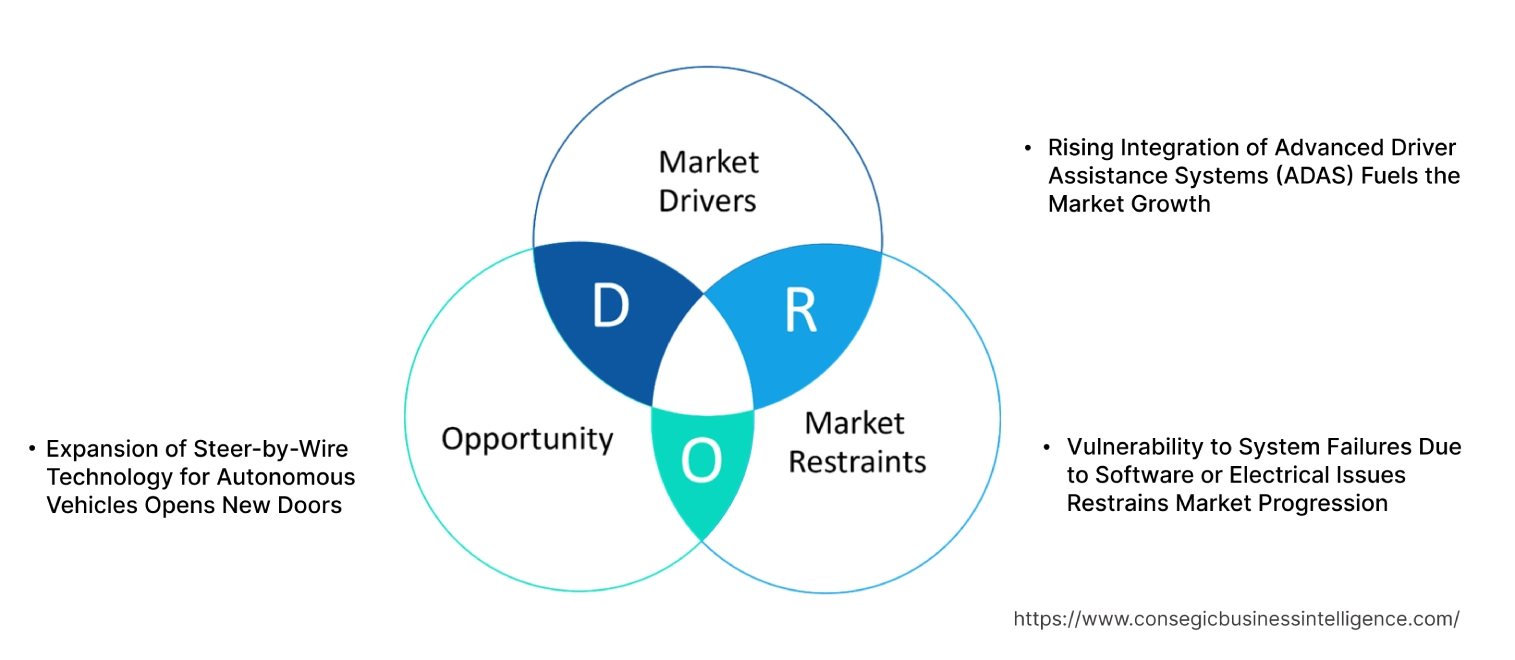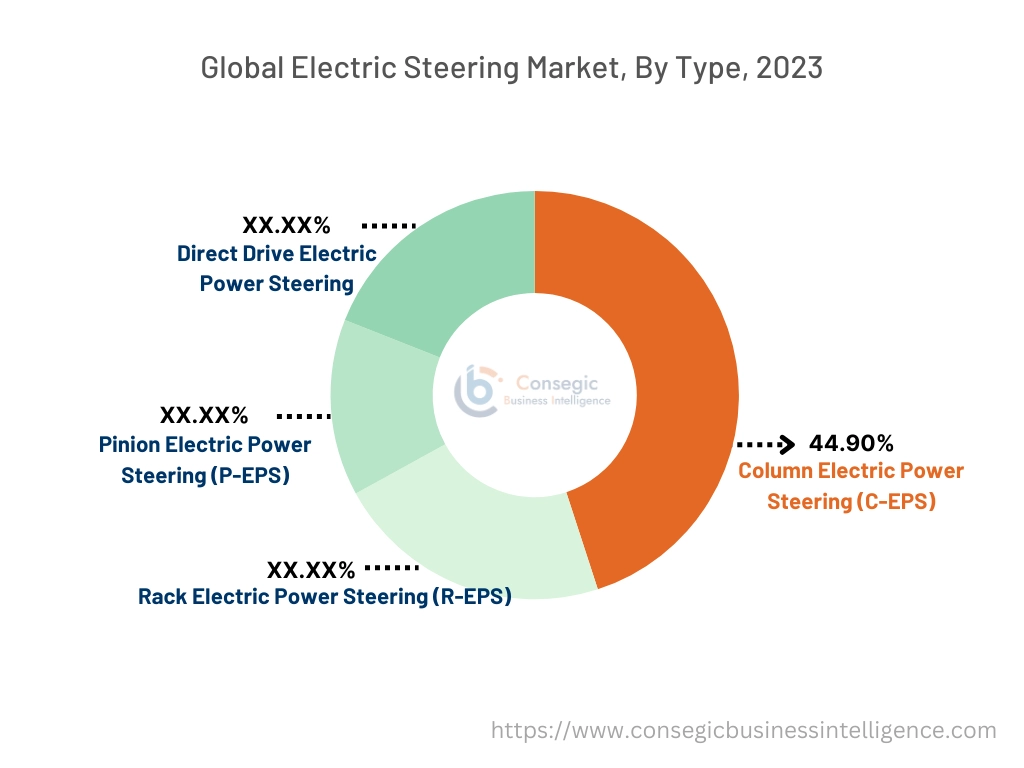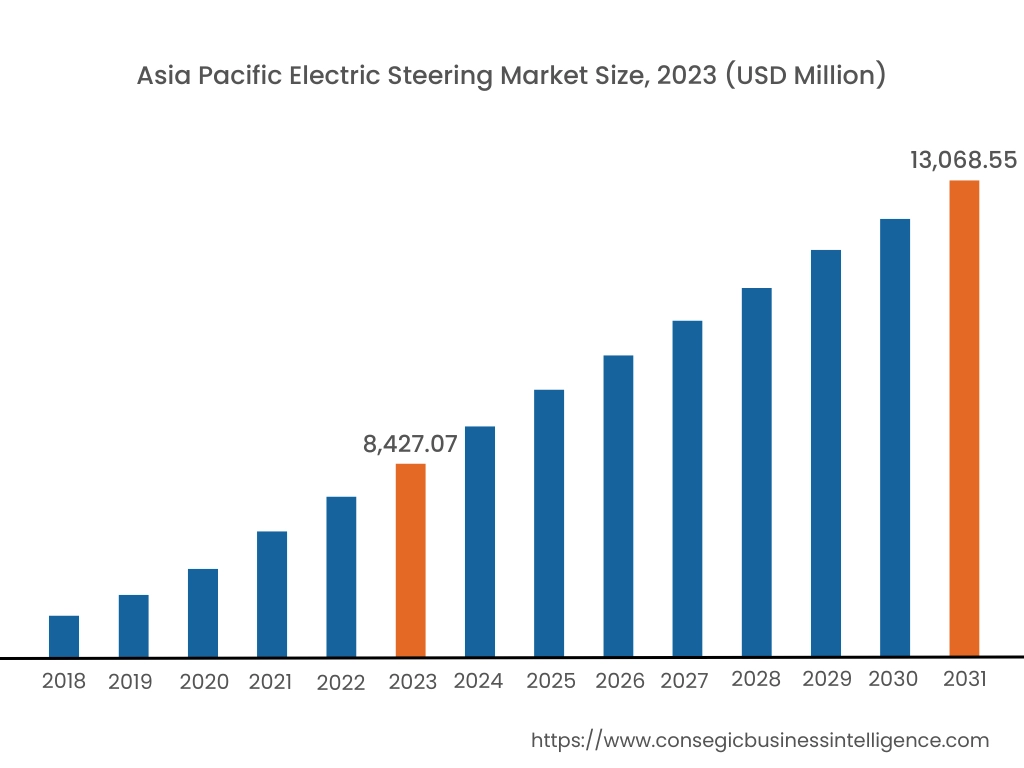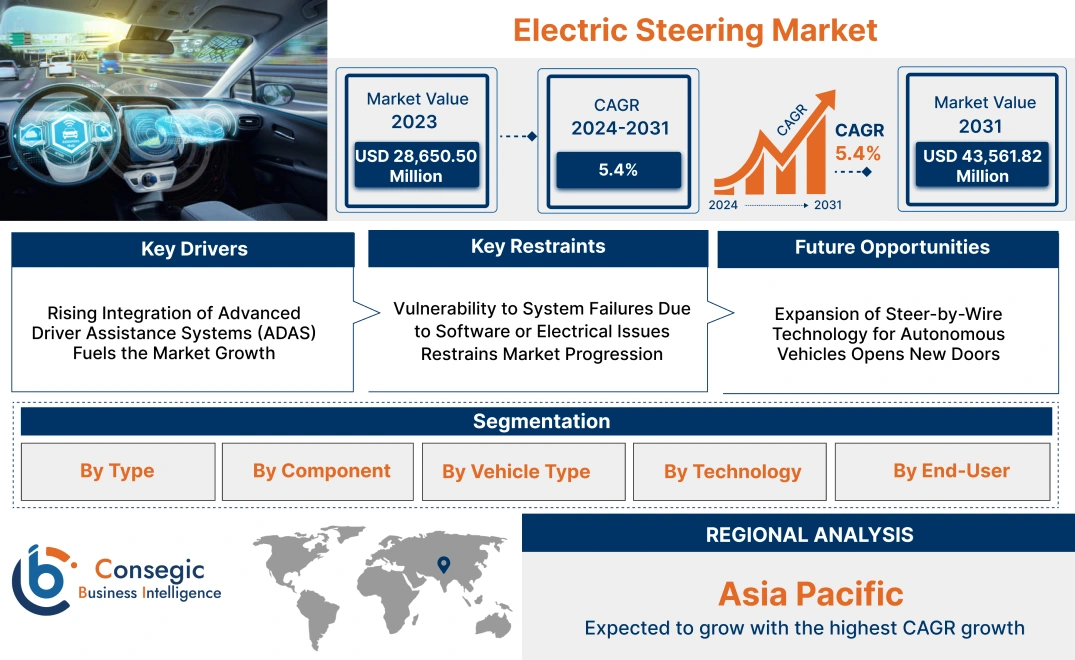- Summary
- Table Of Content
- Methodology
Electric Steering Market Size:
Electric Steering Market size is estimated to reach over USD 43,561.82 Million by 2031 from a value of USD 28,650.50 Million in 2023 and is projected to grow by USD 29,680.77 Million in 2024, growing at a CAGR of 5.4% from 2024 to 2031.
Electric Steering Market Scope & Overview:
Electric steering is an advanced automotive system that uses electric motors to assist in steering control, replacing traditional hydraulic systems. This technology enhances vehicle handling and maneuverability by providing precise and efficient steering assistance. The systems are composed of components such as an electric motor, sensors, and electronic control units, all working together to improve steering performance and reduce energy consumption.
The systems are designed to support various vehicle types, including passenger cars, commercial vehicles, and electric vehicles. These systems offer enhanced features such as speed-sensitive assistance, customizable driving modes, and integration with advanced driver-assistance systems (ADAS), ensuring a safe and comfortable driving experience. Additionally, electric steering systems are lightweight and compact, contributing to overall vehicle efficiency and performance.
End-users of electric steering solutions include automotive manufacturers, fleet operators, and aftermarket service providers. These stakeholders rely on electric steering technology to enhance vehicle functionality, improve driving dynamics, and support the integration of modern automotive technologies.
Electric Steering Market Dynamics - (DRO) :

Key Drivers:
Rising Integration of Advanced Driver Assistance Systems (ADAS) Fuels the Market Growth
The increasing adoption of advanced driver assistance systems (ADAS) in modern vehicles is significantly driving the demand for electric steering systems. ADAS features, such as lane-keeping assist, adaptive cruise control, collision avoidance, and automated parking, rely on precise and responsive steering mechanisms for accurate execution. The systems are particularly suited for these applications as they provide real-time, electronically controlled inputs without the complexity of hydraulic components. These systems enable seamless integration with ADAS, offering improved control, reduced mechanical losses, and enhanced vehicle safety. Regulatory mandates in key markets, such as Europe and North America, requiring the inclusion of safety features like lane departure warning and automatic emergency braking, are accelerating the adoption of ADAS technologies. Simultaneously, growing consumer preferences for vehicles equipped with advanced safety and convenience features are driving automakers to incorporate these systems in both passenger cars and commercial vehicles. As ADAS becomes standard in mid-range and premium vehicles, the integration of advanced steering technologies is driving electric steering market growth, establishing it as a pivotal element of modern vehicle design.
Key Restraints :
Vulnerability to System Failures Due to Software or Electrical Issues Restrains Market Progression
Electric steering systems, while technologically advanced, face inherent vulnerabilities related to software malfunctions and electrical failures, which critically impact safety and performance. Unlike traditional hydraulic systems, electric steering relies entirely on sensors, actuators, electronic control units (ECUs), and complex software algorithms for operation. Failures in any of these components, such as power supply interruptions, software glitches, or sensor inaccuracies, lead to partial or complete loss of steering control, posing significant safety risks. This issue is particularly pronounced in steer-by-wire systems, where the absence of mechanical linkages means total dependence on electronic controls. Harsh operating conditions, such as extreme temperatures, moisture, or vibrations, exacerbate these risks, impacting system reliability. The potential for system failures raises concerns among automakers and regulators, dampening electric steering market demand, particularly for commercial and off-road vehicles where reliability is paramount.
Future Opportunities :
Expansion of Steer-by-Wire Technology for Autonomous Vehicles Opens New Doors
The advancement of steer-by-wire technology presents a transformative opportunity, particularly in the development of autonomous and semi-autonomous vehicles. By eliminating mechanical linkages between the steering wheel and wheels, steer-by-wire systems offer unmatched design flexibility, enabling automakers to reimagine cabin layouts and enhance passenger comfort. These systems rely on electronic signals for precise steering control, which is crucial for autonomous vehicles requiring instantaneous, accurate responses to sensor inputs and driving algorithms.
Steer-by-wire technology also simplifies integration with autonomous driving systems, such as lane-keeping assist, adaptive cruise control, and parking automation, making it a cornerstone of next-generation vehicle architectures. Additionally, the absence of mechanical components reduces weight and mechanical complexity, improving overall energy efficiency. As the adoption of autonomous vehicles gains momentum through consumer demand and regulatory support, electric steering market opportunities are expanding, with rising investments in steer-by-wire systems driving innovation in safety and performance features.
Electric Steering Market Segmental Analysis :
By Type:
Based on type, the market is segmented into Column Electric Power Steering (C-EPS), Rack Electric Power Steering (R-EPS), Pinion Electric Power Steering (P-EPS), and Direct Drive Electric Power Steering.
The Column Electric Power Steering (C-EPS) segment accounted for the largest revenue of 44.90% in 2023.
- C-EPS is widely used in compact and mid-sized passenger vehicles due to its lightweight design and cost-effectiveness.
- This type of steering system is mounted on the steering column, ensuring space-saving and ease of integration with vehicle architecture.
- Automakers favor C-EPS systems for vehicles designed for urban use, where maneuverability and fuel efficiency are prioritized.
- The dominance of the C-EPS segment underscores electric steering market expansion, driven by its adaptability to small and medium vehicles and the global push for compact vehicle production.
The Rack Electric Power Steering (R-EPS) segment is expected to register the fastest CAGR during the forecast period.
- R-EPS systems are primarily used in larger vehicles, such as SUVs and light commercial vehicles, due to their ability to handle higher steering loads.
- These systems provide improved precision and control, enhancing the driving experience for heavy-duty and high-performance vehicles.
- The growth of the R-EPS segment is supported by advancements in rack-mounted technologies and the increasing adoption of electric steering in commercial vehicles.
- As per electric steering market analysis, R-EPS systems are favored in markets with a high demand for premium SUVs and crossovers, reflecting their versatility and reliability.

By Component:
Based on components, the market is segmented into Steering Motors, Steering columns, Sensors, Electronic Control Units (ECU), and Others.
The Steering Motor segment accounted for the largest revenue of the total electric steering market share in 2023.
- Steering motors are a critical component of electric steering systems, converting electrical energy into mechanical torque to assist the driver.
- Advancements in motor technologies, including brushless motors, enhance the efficiency and reliability of the systems.
- The segment's dominance is driven by the increasing adoption of passenger and commercial vehicles globally.
- As per electric steering market trends, Manufacturers are focusing on compact and lightweight motor designs to align with the industry's emphasis on fuel efficiency and sustainability.
The Sensors segment is expected to register the fastest CAGR during the forecast period.
- Sensors, such as torque and position sensors, play a crucial role in providing real-time feedback to the ECU, ensuring precise steering control.
- Increasing demand for advanced driver-assistance systems (ADAS) is driving the integration of high-precision sensors in electric steering systems.
- The rapid progress of this segment is attributed to innovations in sensor technologies, including AI-based and IoT-enabled sensors for enhanced vehicle safety.
- Automakers are integrating advanced sensor systems to enhance steering responsiveness, contributing significantly to electric steering market growth while addressing evolving automotive safety standards.
By Vehicle Type:
Based on vehicle type, the market is segmented into Passenger Vehicles and Commercial Vehicles.
The Passenger Vehicles segment held the largest revenue share of the total electric steering market share in 2023.
- Passenger vehicles are the primary adopters of electric steering systems due to their focus on enhanced driving comfort, fuel efficiency, and vehicle safety.
- Increasing production of electric and hybrid passenger vehicles drives the adoption of advanced electric steering systems across global markets.
- Automakers are incorporating customizable steering systems in passenger vehicles to cater to varying consumer preferences.
- The dominance of the passenger vehicles segment highlights the rising electric steering market demand, driven by the growing preference for advanced steering systems in modern, connected vehicles.
The Commercial Vehicles segment is expected to register the fastest CAGR during the forecast period.
- Electric steering systems in commercial vehicles offer significant advantages in reducing driver fatigue and improving maneuverability for heavy loads.
- The adoption of electric steering in commercial fleets is driven by the increasing emphasis on sustainability and lower maintenance costs compared to hydraulic systems.
- Advancements in e-commerce and logistics industries are propelling the demand for commercial vehicles equipped with electric steering systems.
- The rapid growth of the commercial vehicle segment is driven by advancements in heavy-duty steering technologies and the growing trend of fleet electrification, contributing to the electric steering market expansion.
By Technology:
Based on technology, the market is segmented into Electric Power Steering (EPS) and Electro-Hydraulic Power Steering (EHPS).
The Electric Power Steering (EPS) segment accounted for the largest revenue share in 2023.
- EPS systems eliminate the need for hydraulic components, reducing overall vehicle weight and improving fuel efficiency.
- The growing adoption of EPS systems is driven by their compatibility with modern ADAS features, such as lane-keeping assist and automated parking.
- Automakers are increasingly shifting to EPS systems for passenger and light commercial vehicles due to their simplicity and cost-effectiveness.
- The dominance of the EPS segment is driven by its broad adoption in both entry-level and premium vehicles, creating electric steering market opportunities through improved vehicle performance, efficiency, and reduced weight.
The Electro-Hydraulic Power Steering (EHPS) segment is expected to register the fastest CAGR during the forecast period.
- EHPS systems combine hydraulic and electric mechanisms, offering higher steering loads for heavy-duty applications such as trucks and buses.
- These systems are favored for their ability to provide precise steering assistance in large commercial vehicles while maintaining energy efficiency.
- The rapid progress of the EHPS segment is driven by its application in regions where heavy-duty vehicles dominate the automotive landscape.
- As per electric steering market analysis, advancements in EHPS technologies, including variable steering assist, are further enhancing their adoption in specialized vehicle categories.
By End-User:
Based on end-user, the market is segmented into OEMs (Original Equipment Manufacturers) and Aftermarket.
The OEM segment held the largest revenue share in 2023.
- OEMs are the primary adopters of electric steering systems, integrating them during vehicle manufacturing to ensure optimal performance and compatibility.
- Automakers are forming strategic partnerships with steering system manufacturers to develop customized solutions tailored to specific vehicle models.
- The dominance of the OEMs segment is supported by the increasing production of electric and hybrid vehicles across global markets.
- As per electric steering market trends, the growing focus on innovation and sustainability in the automotive industry further strengthens the OEMs segment's position.
The Aftermarket segment is expected to register the fastest CAGR during the forecast period.
- The aftermarket segment caters to the replacement and upgrade needs of electric steering systems for existing vehicles.
- Increasing vehicle lifespans and the rising awareness about the benefits of electric steering systems drive aftermarket sales.
- The availability of cost-effective, high-quality replacement parts supports the growth of the aftermarket segment, particularly in developing regions.
- As per segmental trends analysis, the rapid progress of this segment reflects the increasing demand for retrofitting advanced steering systems in older vehicle models.
Regional Analysis:
The regions covered are North America, Europe, Asia Pacific, the Middle East and Africa, and Latin America.

Asia Pacific region was valued at USD 8,427.07 Million in 2023. Moreover, it is projected to grow by USD 8,744.61 Million in 2024 and reach over USD 13,068.55 Million by 2031. Out of these, China accounted for the largest share of 42.3% in 2023. Asia-Pacific is witnessing the fastest growth in the market, driven by rapid industrialization and urbanization in countries like China, India, and Japan. The region has become a global hub for automotive production, with a strong emphasis on passenger vehicles to support the growing middle-class population. The increasing demand for advanced vehicle features and the expansion of the automotive industry are further propelling market development.

North America is estimated to reach over USD 14,331.84 Million by 2031 from a value of USD 9,523.19 Million in 2023 and is projected to grow by USD 9,857.25 Million in 2024. North America holds a substantial portion of the market, primarily due to the robust automotive sector and the high adoption rate of advanced vehicle technologies. The United States, in particular, leads the market with a strong demand for electric power steering (EPS) systems in passenger cars and light commercial vehicles. The focus on enhancing vehicle performance and fuel efficiency has led to the integration of EPS systems.
Europe represents a significant portion of the global electric steering market, with countries like Germany, France, and the United Kingdom leading in terms of adoption and innovation. The region benefits from a well-established automotive sector and a strong emphasis on sustainability. The demand for lightweight and fuel-efficient vehicles is increasing, driving the adoption of EPS systems.
The Middle East & Africa region shows promising potential in the market, particularly in countries like Saudi Arabia, the United Arab Emirates, and South Africa. Increasing investments in automotive infrastructure and the proliferation of the luxury vehicle market are driving the demand for vehicles equipped with EPS systems. The focus on diversifying economies and reducing dependence on oil revenues has led to progress in the automotive sector.
Latin America is an emerging market for electric steering systems, with Brazil and Mexico being the primary growth drivers. The rising adoption of passenger vehicles, improving road infrastructure, and increasing focus on enhancing vehicle comfort contribute to the market's enlargement. Government initiatives aimed at modernizing transportation networks and promoting automotive manufacturing are supporting market progression.
Top Key Players & Market Share Insights:
The Electric Steering market is highly competitive with major players providing products and services to the national and international markets. Key players are adopting several strategies in research and development (R&D), product innovation, and end-user launches to hold a strong position in the global Electric Steering market. Key players in the Electric Steering industry include -
- JTEKT Corporation (Japan)
- ZF Friedrichshafen AG (Germany)
- NSK Ltd. (Japan)
- Mitsubishi Electric Corporation (Japan)
- Nexteer Automotive (USA)
- Thyssenkrupp AG (Germany)
- Bosch Group (Germany)
- Mando Corporation (South Korea)
- Showa Corporation (Japan)
- Hyundai Mobis (South Korea)
Recent Industry Developments :
Product Launches:
- In September 2024, Cascade Drives showcased its innovative TrueEPS (Electric Power Steering) solution at the IAA Transportation Show 2024. Designed for heavy-duty vehicles, TrueEPS improves energy efficiency and performance by replacing traditional hydraulic systems with an electric steering solution. This reduces power losses and increases reliability. The technology aims to contribute to the electrification of heavy vehicles, enhancing both environmental sustainability and operational efficiency.
- In August 2024, Suzuki introduced the 2024 KingQuad 750AXi Power Steering SE+ Rugged Package ATV, designed for off-road enthusiasts. This special edition features a rugged utility package with unique accessories and enhancements, including a protective bumper, a winch, and premium alloy wheels. It is powered by a robust engine, providing durability and high performance for challenging terrains. The inclusion of electronic power steering ensures better handling and control.
- In June 2023, Nidec Corporation announced the launch of its new Electric Drive Systems for small electric vehicles, targeting improved efficiency and compactness. The systems include advanced motors and controllers tailored for small EVs like scooters and microcars. These solutions aim to enhance energy savings, reduce environmental impact, and promote broader adoption of electric mobility globally. The development aligns with Nidec's commitment to innovation in EV technology and sustainability.
Product Enhancements:
- In August 2024, Nexteer Automotive introduced a new Modular Pinion Assist Electric Power Steering (EPS) system, expanding its cost-effective modular steering solutions. This addition offers tailored modular versions for all EPS architectures, including Pinion Assist, Rack Assist, and Column Assist systems. The system is designed to optimize performance, simplify manufacturing, and reduce costs while providing scalability to meet diverse customer needs. Modularity enables faster integration and adaptability across various vehicle platforms, supporting advancements in electric and autonomous vehicle technologies.
Electric Steering Market Report Insights :
| Report Attributes | Report Details |
| Study Timeline | 2018-2031 |
| Market Size in 2031 | USD 43,561.82 Million |
| CAGR (2024-2031) | 5.4% |
| By Type |
|
| By Component |
|
| By Vehicle Type |
|
| By Technology |
|
| By End-User |
|
| By Region |
|
| Key Players |
|
| North America | U.S. Canada Mexico |
| Europe | U.K. Germany France Spain Italy Russia Benelux Rest of Europe |
| APAC | China South Korea Japan India Australia ASEAN Rest of Asia-Pacific |
| Middle East and Africa | GCC Turkey South Africa Rest of MEA |
| LATAM | Brazil Argentina Chile Rest of LATAM |
| Report Coverage |
|
Key Questions Answered in the Report
How big is the Electric Steering Market? +
Electric Steering Market size is estimated to reach over USD 43,561.82 Million by 2031 from a value of USD 28,650.50 Million in 2023 and is projected to grow by USD 29,680.77 Million in 2024, growing at a CAGR of 5.4% from 2024 to 2031.
What specific segmentation details are covered in the Electric Steering Market report? +
The Electric Steering Market report includes segmentation details for type (Column Electric Power Steering (C-EPS), Rack Electric Power Steering (R-EPS), Pinion Electric Power Steering (P-EPS), Direct Drive Electric Power Steering), component (Steering Motor, Steering Column, Sensors, Electronic Control Unit (ECU), Others), vehicle type (Passenger Vehicles, Commercial Vehicles), technology (Electric Power Steering (EPS), Electro-Hydraulic Power Steering (EHPS)), and end-user (OEMs, Aftermarket).
Which is the fastest-growing segment in the Electric Steering Market? +
The Sensors segment is expected to register the fastest CAGR during the forecast period, driven by the increasing integration of advanced driver-assistance systems (ADAS) that rely on high-precision sensors for enhanced vehicle safety and performance.
Who are the major players in the Electric Steering Market? +
The major players in the Electric Steering Market include JTEKT Corporation (Japan), ZF Friedrichshafen AG (Germany), NSK Ltd. (Japan), Mitsubishi Electric Corporation (Japan), Nexteer Automotive (USA), Thyssenkrupp AG (Germany), Bosch Group (Germany), Mando Corporation (South Korea), Showa Corporation (Japan), and Hyundai Mobis (South Korea).

